

Picture 427 « 20 Classrooms From Around The World. Is This Now A Typical Classroom? 11.28K Views 0 Likes When you imagine a 'typical classroom' - what do you picture? If it's a boatload of laptops facing you with students hiding behind the screens, you're not far off. 7 Online Quiz Tools Perfect For Classrooms 19.21K Views 0 Likes Whether you want to have students turn in homework via an online form or simply take a quiz or test, online quiz tools are critical to having a connected classroom.
Why Education Matters. Get Ready For The Madness: Next Month's Schedule of New Mobile Device Announcements. During any given year, new mobile devices are announced and released like clockwork.
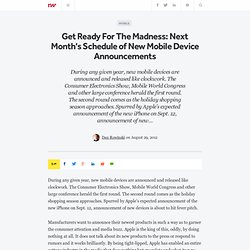
The Consumer Electronics Show, Mobile World Congress and other large conference herald the first round. The second round comes as the holiday shopping season approaches. The Continuing Evolution of the Internet. A few weeks ago I had an interesting discussion with Bob Kahn.
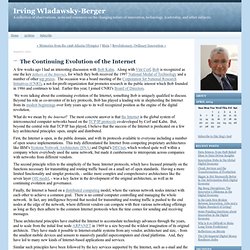
Along with Vint Cerf, Bob is recognized as one the key fathers of the Internet, for which they both received the 1997 National Medal of Technology and a number of other top prizes. The occasion was a board meeting of the Corporation for National Research Initiatives (CNRI), a not-for-profit organization that promotes research in the public interest which Bob founded in 1986 and continues to lead. Earlier this year, I joined CNRI’s Board of Directors. We were talking about the continuing evolution of the Internet, something Bob is uniquely qualified to discuss.
Beyond his role as co-inventor of its key protocols, Bob has played a leading role in shepherding the Internet from its modest beginnings over forty years ago to its well recognized position as the engine of the digital revolution. What do we mean by the Internet? The evolution continues. DNA used to encode a book and other digital information. (Phys.org) -- A team of researchers in the US has successfully encoded a 5.27 megabit book using DNA microchips, and they then read the book using DNA sequencing.
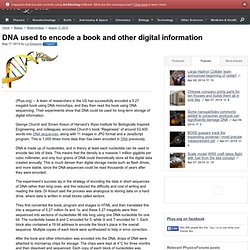
Their experiments show that DNA could be used for long-term storage of digital information. George Church and Sriram Kosuri of Harvard’s Wyss Institute for Biologically Inspired Engineering, and colleagues, encoded Church’s book “Regenesis” of around 53,400 words into DNA sequences, along with 11 images in JPG format and a JavaScript program. Gorgeous 1939 map of physics. I love this Map of Physics that turns an entire academic discipline into a fictional country, showing the way different sub-disciplines interact and the concepts that connect seemingly disparate discoveries.
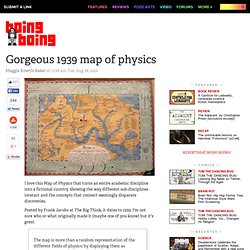
Posted by Frank Jacobs at The Big Think, it dates to 1939. 4 Reasons Not To Autopost Your Blog Articles To Social Media. A lot of businesses set their blogs up for autoposting across all of their social media channels.

Beyond our Kuhnian inheritance. The history and philosophy of science inherited a huge legacy from Thomas Kuhn, but it has not stood still for the last 50 years.
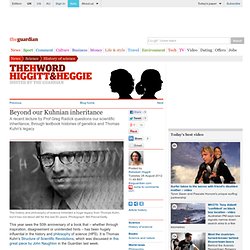
Photograph: Bill Pierce/Getty This year sees the 50th anniversary of a book that – whether through inspiration, disagreement or unintended hints – has been hugely influential in the history and philosophy of science (HPS). It is Thomas Kuhn's Structure of Scientific Revolutions, which was discussed in this great piece by John Naughton in the Guardian last week. For me, Kuhn's influence feels somewhere near second or third hand. Responses to him informed the work of my tutors and supervisors, and have long been part of the daily bread of those training in HPS.
Better teaching sends science A-levels to a new high. 16 August 2012Last updated at 08:13 ET By Pallab Ghosh Science correspondent, BBC News Exciting new findings may be attracting students to study physics.

Groups - EJC - Online Journalism Community. Thomas Kuhn: the man who changed the way the world looked at science. Fifty years ago this month, one of the most influential books of the 20th century was published by the University of Chicago Press.

Many if not most lay people have probably never heard of its author, Thomas Kuhn, or of his book, The Structure of Scientific Revolutions, but their thinking has almost certainly been influenced by his ideas. The litmus test is whether you've ever heard or used the term "paradigm shift", which is probably the most used – and abused – term in contemporary discussions of organisational change and intellectual progress. A Google search for it returns more than 10 million hits, for example. And it currently turns up inside no fewer than 18,300 of the books marketed by Amazon. Photo of the Day. Society for General Microbiology. A fresh chapter for organic data storage. A double-stranded DNA molecule A trio of researchers has encoded a draft of a whole book into DNA.
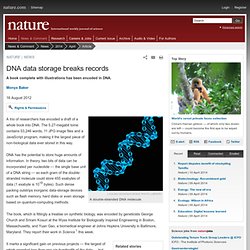
The 5.27-megabit tome contains 53,246 words, 11 JPG image files and a JavaScript program, making it the largest piece of non-biological data ever stored in this way. DNA has the potential to store huge amounts of information. Is e-learning effective? Pointless question. By katiek2 Is paper a more effective teaching medium than speech?

Stupid question isn't it? Evolutionary increase in size of the human brain explained. Researchers have found what they believe is the key to understanding why the human brain is larger and more complex than that of other animals. The human brain, with its unequaled cognitive capacity, evolved rapidly and dramatically. "We wanted to know why," says James Sikela, PhD, who headed the international research team that included researchers from the University of Colorado School of Medicine, Baylor College of Medicine and the National Institutes of Mental Health. "The size and cognitive capacity of the human brain sets us apart. But how did that happen? " Raw Images. Tarmo Weekly. Bases for bits, a book is written as DNA. We're getting so good at sequencing DNA that it's beginning to create a data crisis as we struggle to store all the data coming off the sequencing machines. Now, however, some researchers have reversed the process, taking some information—an entire book—and storing it in the form of DNA.
And they find that it is actually a very efficient form of storage, although reading and writing remains a hassle. The complexity of designing for everywhere. In her new book The Mobile Frontier, author Rachel Hinman (@Hinman) says the mobile design space is a wide-open frontier, much like space exploration or the Wild West, where people have room to “explore and invent new and more human ways for people to interact with information.” In the following interview, Hinman talks about the changing landscape of computing — GUIs becoming NUIs — and delves into the future of mobile and how designers and users alike will make the journey.
What is mobile’s biggest strength? What about it is creating a new frontier? Rachel Hinman: Humans have two legs, making us inherently mobile beings. Changing Shape: How Device Selection Signals User Intent. Does More Tech in the Classroom Help Kids Learn? WASHINGTON: As more educational programs turn digital, teachers are finding that blending technology into the learning experience offers kids a crucial leg up in the classroom. Deeper Learning. 20 Schools Innovating With Digital Tools - Getting Smart by Tom Vander Ark - DigLN, edchat, edteche. Animations. Curiosity's Seven Minutes of Terror Video. Self archiving science is not the solution. Social Network. A Robot That Prints Buildings Out Of Sand And Soil. Four architecture students in Spain have developed a robotic 3-D printer that’s designed to magically turn dirt into chairs, walls, and even full-blown bridges. Patrick Ness: censorship in the internet age.
Why Online Education Won't Replace College - Commentary. Telecoms. At Google we believe in the power of an open and dynamic Internet to drive innovation, investment and economic growth. Here's an Omical Tale: Scientists Discover Spreading Suffix. PDT to UTC Converter. Disrupting Pedagogies in the Knowledge Society: Countering Conservative Norms with Creative Approaches (9781613504956): Julie Faulkner. Schools and universities are traditionally spaces where skills are learned and, in some cases, knowledge gained. Www.igi-global.com/viewtitlesample.aspx?id=61793&ptid=55283&t=teachers of young children: moving students from agents of surveillance to agents of change. Software for Business Studies. Software. Www.igi-global.com/viewtitlesample.aspx?id=61794&ptid=55283&t=creating tension: orchestrating disruptive pedagogies in a virtual school environment.
It's a small world! Between fevers, congestion and diarrhea, there are numerous ways that microbes can make us feel sick. A quantum optimizer folds its first proteins. How to Teach a Journalist Programming. What is linked data? - From head to the Web. From head to the Web - powered by FeedBurner. Bonniestewart - home. Cribchronicles.com. Latest news from Music Education UK. Rhizomatic Education : Community as Curriculum. There’s only one truly open platform — the web. What every journalist needs to know about links. Applet HTML Page.